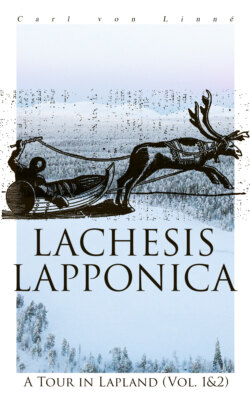Читать книгу Lachesis Lapponica: A Tour in Lapland (Vol. 1&2) - Carl von Linné - Страница 15
На сайте Литреса книга снята с продажи.
May 23.
ОглавлениеAfter having spent the night at Normaling, I took a walk to examine the neighbourhood, and met with a mineral spring, already observed by Mr. Peter Artedi17, at this his native place. It appeared to contain a great quantity of ochre, but seemed by the taste too astringent to be wholesome. It is situated near the coast to the west, on the south of the church, and at no great distance from it.
I observed on the adjacent shore that an additional quantity of sand is thrown up every year by the sea, which thus makes a rampart against its own encroachments, continually adding by little and little to the continent.
A mile, or rather more, from the land, is an island named Bonden, where the bird called Tordmule (Alca Torda) lays its eggs every year. These are collected every season by the peasants, who assured me that the bird never lays above one egg in a year, except that egg be taken away, and then she will repeatedly lay more. It seems to me a very curious circumstance, and scarcely possible, that the increase of the species every year should be naturally not more than one. Some persons indeed told me these birds laid two eggs. It is certain that the size of the egg is very large compared with the body of the parent. I only saw some fragments of this bird, but am pretty certain of its being the Anas arctica (Alca Torda).
In proportion as I approached Westbothland, the height of the mountains, the quantity of large stones, and the extent of the forests, gradually decreased. Fir trees, which of late had been of rare occurrence, became more abundant. Above a mile before we come to Sörmjole, is a river called Angeræn, separating Angermanland from Westbothland.
The peasants hereabouts use the following implements, for breaking up the ground of their fallow fields.
No. 1 is a plough drawn by a horse. b, b, is a strong thick-backed knife, placed in the middle of the plough, and serving to cut straight lines through the grassy turf, which in the course of five or six years has accumulated on the soil.
No. 2 is used immediately afterwards, to cut the clods of turf from their base and turn them up. Of this a is the handle, as in No. 1, held by the ploughman's right hand; b the main beam of the plough; c the part which goes under the surface of the ground, and is terminated in the fore part by the plough-share; d, which is formed obliquely, turning towards the outside, not towards the man who guides the plough; e is placed on the top horizontally, reaching to the base of the plough-share, serving to turn over the clods. The whole is drawn by a horse, the only kind of animal used here in husbandry.
No. 3, p. 65, is a hoe, which, when furnished with a handle, serves to pare the earth from the under side of the turfs, after they are turned over by the machine last described. The first year after this operation they sow rye, but in the following season barley, when the turfs are become rotten.
13. Linnæus soon satisfied himself that the latter was his Rubus Chamæmorus. The arcticus is a much more valuable plant for its fruit, which partakes of the flavour of the raspberry and strawberry, and makes a most delicious wine, used only by the nobility in Sweden.
14. Its perpendicular height is two hundred Swedish ells. See Dissert. de Angermanniâ.
15. This cavern has been visited by other naturalists since the time of Linnæus, among whom was Dr. Olaf Swartz, the present Bergian Professor of Botany at Stockholm, well known by his various excellent publications, who gathered here the same Byssus (cryptarum) which Linnæus found in the other cavern at Brunæsberget. Both their original specimens are now in my possession.
16. How would this very good bread suit English stomachs? This honest adulteration has not been thought of by any of our schemers, whose projects only serve to teach evil-disposed bakers to make bread of any thing rather than what they ought, and to spare their pockets at the expense of the public welfare.
17. The celebrated writer on fishes, afterwards so intimately connected with Linnæus. The latter published his Ichthyology, and wrote his life in a style which does equal honour to his own feelings and the merit of his friend.
